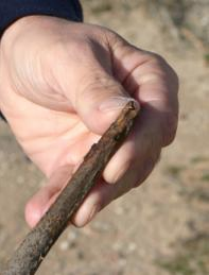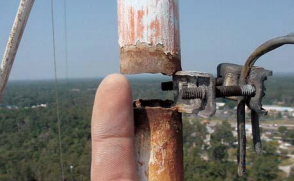Ignoring Tower Maintenance is Bad Business
[July 2012] When accomplished properly, routine maintenance extends the useful life of most everything we use – from clothes to cars, from microphones to broadcast towers. Ignore it at your peril.
Have you ever grabbed a shirt while in a hurry, only to find several buttons missing? Or, pulling on a pair of trousers to run out to an emergency, only to find a hole in the seat?
Whether you consider the mental picture humorous, an inconvenience, or worse, you will agree while it was certainly not a life-ending matter, it was totally avoidable.
The same can be said for much more important issues, namely the condition of your broadcast chain.
A Single Point of Failure
Everyone hates dealing with a “Single Point of Failure.” As much as possible, stations put a lot of effort in having spares for as much of the broad-cast chain as possible – or at least a plan to work around problems in unique gear when they occur.
For that reason, most stations have an auxiliary transmitter and generator, for example, to cope with emergencies like power loss. But, for most stations, perhaps the most crippling event they can have is the loss of a tower, taking the station off the air. Borrowing a spare tower and rolling in on the spot is just not so easy to do.
All too often, broadcast towers have become part of the landscape. We know they are there, standing tall, and we just assume they always will be there. That is, until one falls over when a guy anchor fails or a rusted member gives way.
And that happens more than it should.
Unpredictable Causes
Well, sure, you cannot predict a tornado, a hurricane, an ice storm, nor a flood. These so-called “natural events” can take down even a wellplanned and well-built tower in an instant.
At the same time, it would wrong to assume that just because a tower “sprouted” some more antennas and dishes that it was suddenly overloaded. In truly extreme weather, towers fall. Even a microburst can create enough stress to cause failure. There just is not too much you can do about that.
And the Predictable
On the other hand, in too many situations managers see maintenance budgets as “easy” to cut or eliminate. After all, “that tower has stood there for 40 years,” they reason. “Surely it will get through a few more years of service.”
It is those towers, the ones that have not been maintained – or have been maintained by incompetent tower crews – which present the greatest danger of failure and concomitant loss of air time and station income. From loose guy 2 wires to rusted members, they have become a time bomb.
For example, one four-tower directional AM had a guy anchor failure due to poor construction practices.
A fairly young installation, the land was so corrosive the guy anchor was just eaten up.

After the crew which repaired this tower, they reported to station management that the other towers needed attention, lest they also suffer catastrophic failure.
Despite the good advice, the owner refused to spend the cash. It was less than four months later when a microburst came through and knocked over one of the other towers – which then hit yet another tower, dropping it.
As it turned out, the station operated on the remaining two towers and 25% power for well over a year and a half. Plus, the total repair costs were much larger than it would have cost to have inspected and fixed the problems ahead of time.
“Hey! I Can See Through the Leg!”
Another tower crew got a major surprise when they were called to inspect a tower. As the climbers got about half way up a stick and saw this:

You can well understand why they rapidly moved away from this leg, and all of them got off the tower except for one courageous worker who very carefully repaired the gap. Before leaving the site, the crew made sure the tower was stable, and pointed out the need for regular maintenance, including a proper coating of tower paint.
And Then it Gets Worse
Not long ago, a station in Florida had an 18- month horror story dealing with tower problems, the FCC, and local zoning authorities.
It was a small station in a small town. Tower maintenance was pretty much nonexistent until a beacon went out. However, when the flashing beacon did fail and the station got a Notice of Violation from the FCC, a tower crew was called – and promptly walked away. The tower was just too dangerous to climb.
It was too late to repair the tower. The crew quite reasonably recommended dropping the tower and replacing it, with the station going off the air during the work.
Unfortunately, the station now was caught in a regulatory vise. The city would not permit the tower to be replaced, due to non-conforming zoning. The FCC, meantime, was not happy about the continued lack of flashing beacon and levied a stiff fine. The city would not give in, 3 even to the FCC; the FCC would not reduce the fine. It was a mess!
In the end, the station moved their site to the next town and built a 199-foot tower, so they would not need to light it. Yet, much of their problem likely would have been averted by proper maintenance on the tower before things got too back.
Take a Look Now
In each of these three situations mentioned, the costs and urgency of action were exacerbated by the lack of planned, routine maintenance of the towers involved.
The challenge for stations is to budget for, find, and use a competent tower crew to do regular inspections of the tower(s). This is a bit more difficult than it used to be. Insurance rates have skyrocketed, even for experienced companies.
Part of the problem has been the tremendous number of cellular systems being built-out in the last few years, often by poorly or untrained climbers. The resulting dangers were highlighted by a PBS program which looked into the increased fatalities which accompany inexperience.
How can you find a good tower crew, one that will work competently at a reasonable price? What should they do for you? How much supervision should you supply?
These are good questions and we will address them in upcoming installments of this series.
